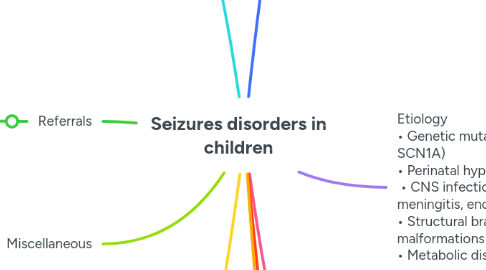
1. Types Os Seizures
1.1. Focal, seizures originate in one specific area of the brain
1.2. Generalized Seizures, both hemispheres of the brain
1.3. Febrile seizures, triggered by fevers
1.4. Signs and Symptoms
1.4.1. Clinical presentation varies based on seizure type but may include: - Generalized tonic-clonic seizures: sudden loss of consciousness, muscle stiffening, rhythmic jerking, and postictal drowsiness - Absence seizures: brief episodes of staring or unresponsiveness - Focal seizures: localized motor or sensory disturbances, which may involve altered awareness - Auras: sensory disturbances preceding the seizure, such as visual or olfactory changes - Postictal state: confusion, fatigue, or headache following a seizure These signs can vary in intensity and frequency and may be mistaken for behavioral issues, delaying diagnosis (Keller, 2023; Rogat et al., 2025).
2. Referrals
2.1. • Pediatric neurologist • Neuropsychologist • Special education services • Family counseling/support groups
3. Miscellaneous
3.1. • Caregiver role strain (emotional fatigue, lifestyle limitations) • Need for ongoing family education and support
4. References
4.1. Alashal, N., & Hussain, N. (2025). Approach to the use of rescue medications in children for prolonged epileptic seizures in the community. *Paediatrics and Child Health, 35*(4), 113–117. https://doi.org/10.1016/j.paed.2025.01.004
4.2. Keller, B. (2023). The Children's Corner: Perspectives on Supportive Care. Caring for Youth and Families Affected by Seizure Disorders. *Pediatric Nursing, 49*(1), 48–44. https://doi.org/10.62116/pnj.2023.49.1.48
4.3. Rogat, Z., Miranovit, V., Dimitrijevit, A., Andrit, L., & Stevanovic, D. (2025). The impact of certain anti-seizure medications on cognitive status, behavior, anxiety, and depression in school-aged children with newly diagnosed epilepsy - a six-month follow-up study. *Srpski Arhiv Za Celokupno Lekarstvo, 2025*(3-4), 170–175. https://doi.org/10.2298/SARH250130029R
5. Pathophysiology
5.1. • Neuronal hyperexcitability • Neurotransmitter imbalance (e.g., GABA vs. glutamate) • Abnormal electrical discharges in cerebral cortex
5.2. Seizures in children are the result of abnormal and excessive neuronal discharges in the brain, typically caused by a disruption in the balance between excitatory and inhibitory neurotransmission. The excitatory neurotransmitter glutamate and the inhibitory neurotransmitter GABA (gamma-aminobutyric acid) play critical roles in maintaining this balance. When excitatory input overwhelms inhibitory control, a seizure can be triggered (Alashal & Hussain, 2025). In many pediatric cases, seizure activity may be focal—originating from a specific area of the brain—or generalized, affecting both hemispheres. These abnormal discharges can be precipitated by underlying structural abnormalities, metabolic disturbances, or genetic mutations, leading to hyperexcitability of the neuronal membranes and increased susceptibility to recurrent seizures (Rogat et al., 2025).
6. Etiology • Genetic mutations (e.g., SCN1A) • Perinatal hypoxia/ischemia • CNS infections (e.g., meningitis, encephalitis) • Structural brain malformations • Metabolic disorders
6.1. The etiology of seizure disorders in children is diverse and includes genetic, structural, infectious, metabolic, and immune-mediated causes. Common etiologies include: - Genetic factors, such as mutations in ion channel genes (e.g., SCN1A) - Structural brain abnormalities, including cortical dysplasia or traumatic brain injury - Infections, such as meningitis or encephalitis - Perinatal insults, including hypoxic-ischemic encephalopathy or intraventricular hemorrhage - Metabolic disturbances, such as hypoglycemia or electrolyte imbalances These factors disrupt normal neuronal function, predisposing the child to seizure activity (Keller, 2023; Rogat et al., 2025).
7. Risk Factors • Family history of seizures or epilepsy • Febrile seizures in early childhood • Developmental delays or cerebral palsy • History of CNS infections or trauma • Low birth weight or birth complications
7.1. Children with multiple risk factors often require early neurological evaluation and close monitoring (Keller, 2023; Alashal & Hussain, 2025).
8. Diagnostics
8.1. • • Electroencephalogram (EEG) • • Brain imaging (MRI/CT) • • Genetic/metabolic panels • • Lumbar puncture (if infection suspected)
9. Treatment Options
9.1. • Antiseizure medications (e.g., levetiracetam, valproate) • Ketogenic diet • Surgical intervention (e.g., lobectomy) • Vagus nerve stimulation (VNS) • Responsive neurostimulation (RNS)
9.1.1. Rescue Medications • Intranasal midazolam • Buccal midazolam • Rectal diazepam
